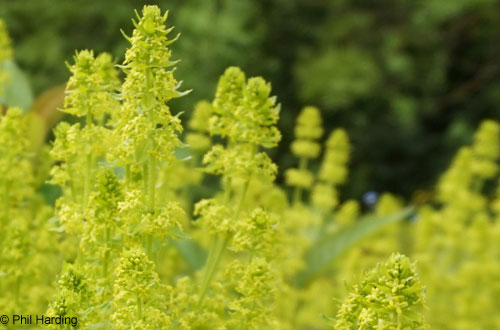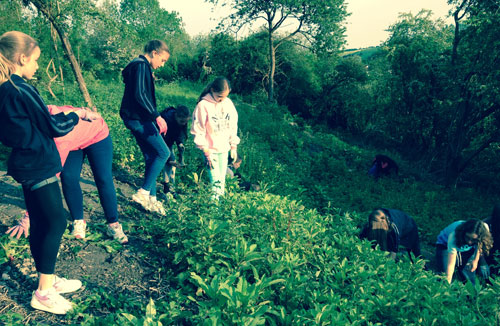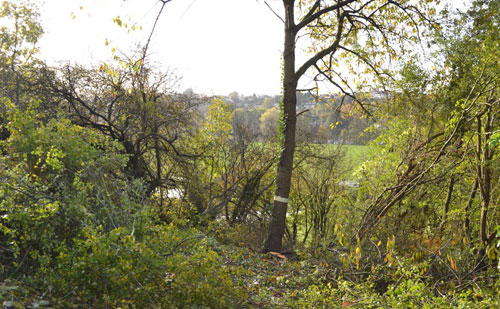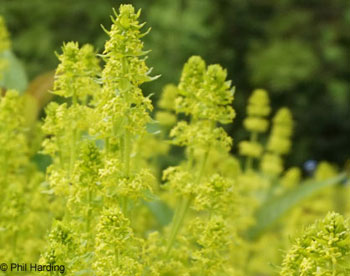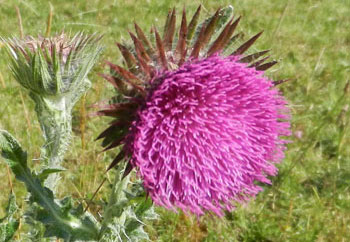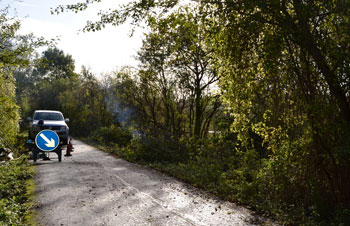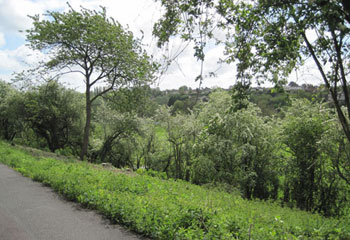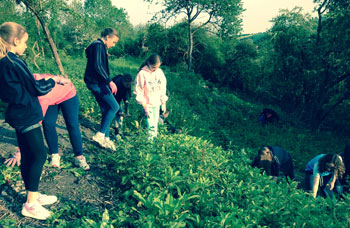|
Saltford Environment Group
|
| Home | About Us | News | Website Contents & Links | Contact |
|
SEG Home > Wildlife > Railway Path Habitat Restoration Project Railway Path Habitat Restoration ProjectSummer 2018 sitrepWe are pleased to report that Sustrans (link), as part of its Greenways initiative, is now leading on maintaining the previously opened area, and, if person-power allows, perhaps even expanding it. Andy Richman is co-ordinating this project for Sustrans. If you wish to volunteer with Sustrans visit: www.sustrans.org.uk/volunteer-sustrans. Summer 2017 sitrepWe continue to have a vacancy for a volunteer coordinator for this project (details below). Hence, activities in 2017 so far have been restricted to essential maintenance, in particular preventing the reversion of the small part of the area from which coarse growth has been largely banished. A number of wild flowers locally scarce in the Saltford area have been present this year. Notably, Crosswort has extended considerably from its area of last year. We shall review the best way to carry this project forward in the autumn but in the meantime if you wish to volunteer to coordinate this project please contact our Vice-Chairman Chris Warren (email cherokee1883@live.com). New opportunity in 2017 to coordinate this projectSaltford Environment Group is looking for a new volunteer to be our railway path habitat restoration project coordinator as our existing coordinator has had to step down due to other commitments. This local project has seen some notable successes:
The area needs some concerted effort over the next 2-3 years to prevent the area from reverting back to scrub and trees: obscuring views and shading some of the rare sun-loving plants that have so recently returned. This work is likely to involve:
This is a great opportunity for someone with good organisational skills to help deliver a really exciting project: restoring a rare and beautiful habitat and bringing members of the community together through fun, practical activities. No prior experience of wildlife conservation projects is required and there will be plenty of opportunities to learn more about the rare and beautiful plants and animals which would otherwise disappear from our area, to make new friends and learn new skills along the way. We are looking for someone with a can-do attitude and the enthusiasm to engage with volunteers and provide more of a social side to this worthwhile activity. If this opportunity to manage and develop a small yet interesting and local outdoor project appeals to you, to express an interest please contact our Vice-Chairman Chris Warren (email cherokee1883@live.com). 2016 sitrepOur project to regenerate the habitat beside a stretch of the cycle path, along the old LMS railway line, made a great start in spring 2016 under the supervision of a new project coordinator, Odette McCarthy. The plan is to recreate a habitat similar to that in the 1960s when railway gangers used to maintain the embankment slopes. At that time there were very long lengths of rough grassland, rich in herbs, wild flowers and the insects associated with them. Having cleared a section of trees a couple of years ago there are now splendid views to the west over the river. Sunlight now reaches the bank allowing grasses to flourish. Already some flowering plants are returning; there is a large area of ground ivy and several patches of crosswort (which isn't found any where else on Saltford). However, the sunlight enjoyed by walkers, cyclists and flowering plants is also enabling nettles and brambles to grow strongly, which could smother the target species. This is where volunteers come in. During 2016 we were out out several times, using a brush cutter to trim a large area at the top of the bank and hand pulling unwanted plants from around the ground ivy and crosswort patches. This local project has seen some notable successes:
May 2015 progress and situation report
In winter 2013/2014 SEG cleared several decades' growth of woody scrub along a short section of the railway path embankment (the former LMS railway-line) to allow a reversion to the flower-rich rough grassland which, up to the late 1970s, dominated much of the line's embankment and cutting sides. In summer 2014, we focussed on weeding out Himalayan Balsam, a highly invasive, prolifically seeding, patch-forming annual from the Himalaya, and of minimal value to wildlife in the UK. This had arrived on the slope in the 1980s, from seed washed down the river and moved - slowly, given its mode of seed dispersal - uphill such that by 2014 it was well positioned to carpet the newly cleared areas, which it duly did. Balsam-pulling was supplemented with a few cuts by strimmer to control coarse perennials such as Common Nettle and Goosegrass, and manual topping of woody regrowth, notably of brambles, wild roses and Common Hawthorn. Apart from the balsam, these named plants are of high or even outstanding (nettles, brambles) wildlife interest; but, being strong competitors, they now dominate many large patches and strips in and around Saltford, whereas a whole host of less competitive grassland plants - and their associated insects - are now gone or almost gone from Saltford. In mid May 2015, several successes and challenges have become evident. Among the early successes, several large patches of Crosswort (pictured above) are obvious. This yellow-flowered bedstraw was formerly abundant in Saltford, but had been close to local total destruction and loss. Large areas of the patch are dominated by Ground-ivy; this is not related to Ivy, the evergreen vine, but is a relative of mint (but lacking strong aromatic oils). It remains common in Saltford, but such large patches are of high value because it is one of the first spring plants to bloom that produces copious nectar; on warm, calm, sunny days in late March the bank was full of nectar loving insects at the Ground-ivy. There is also a good growth of Garlic Mustard, the main food-plant of the Orange-tip butterfly. Several other showy native wild-flowers, such as Red Campion and Cow Parsley, give the bank a very different look from the otherwise scrub-dominated rest. But these flowers are amidst several unwanted species which, if left to themselves would, in combination, reverse the gains. A few Himalayan Balsam seedlings are coming up, from the few plants which were missed during last year's uprooting. Many of the woody stumps are still sprouting regrowth, particularly bramble, Dogwood and Hawthorn. Nettles and Cleavers both seeded profusely in 2014 (when there was an insufficient number of total cuts) and will soon outcompete the weaker competitors. A worrying number of Buddleja seedlings are establishing, evidently from seeds blown over from the large populations in the town (notably the former railway station) to the south west. Fortunately, there is no sign of the alien Giant Hogweed; this serious hazard to human health has recently appeared nearby on the line, from seeds scattered (whether unintentionally or intentionally is not known) by persons unknown in 2013. Thus, activities during the 2015 growing season will focus on:
Girl Guides helping with the project
Many thanks to Saltford Girl Guides who spent the evening of 21st May 2014 pulling weeds and in particular Himalayan Balsam at the project's cleared area. Their enthusiasm and effort in clearing so much of the re-growth in one session is much appreciated. On two evenings in July 2014 a small team of 6 SEG volunteers pulled out and cleared the huge volume of the invasive, fast growing and damaging Himalayan Balsam from the project area. Having cleared this we re-checked regularly for any fresh growth and uprooted it to avoid the production of new seeds. It was important that we prevented this invasive plant from re-seeding itself so that there was a lot less to remove in subsequent years. An opportunity to get involved
(Volunteers are also asked to read 'Instructions and Advice for Volunteers' below) The clearance of woody regrowth (young trees) and other coarse tall vegetation on an initial stretch of the west facing embankment of the Bristol to Bath railway path was completed during autumn-winter 2013/14. Our objective is to allow the natural process of re-establishing insect-friendly herb-rich rough grassland whilst re-opening views across the fields to the river and our village. Numerous insects have been observed in the cleared area during sunny spells. The east embankment is purposefully left untouched by this project as it provides vital protection from chilling east winds and connectivity along the railway path for scrub and young woodland species. The older trees have been deliberately left in situ in agreement with the Avon Frome Partnership that is also hoping to arrange in the future for the trees along the field perimeter at the lower bottom edge of the embankment to be layered into a hedge thus providing further wildlife habitat. Similarly, much of the cut wood has been heaped at the bottom of the slope, where (because of the overgrown hedge) it will not shade the cleared slope. Decaying wood is itself a rich, important wildlife habitat. Our summer 2014 objective for this stretch of cleared embankment was to clear away in particular Himalayan Balsam (see our wildlife page for details on why this invasive plant is such a threat to the local ecology), tall perennial weeds and any new tree saplings, shoots etc. so that the grass and wild flowers can regrow in the sunlight. Small amounts of non-degrading litter also need clearing periodically. In 2014 we successfully cleared the upper parts of the embankment slope of Himalayan Balsam and a regular watch for any re-appearance and removal of this plant is being maintained thereafter. From 2015 our activities have been restricted to essential maintenance with occasional organised clearance sessions and in particular preventing the reversion of the small part of the area from which coarse growth has been largely banished. Instructions & Advice for VolunteersBelow is our original advice for SEG's volunteers and this gives our methodology for clearing unwanted invasive/alien plants etc. From summer 2018 Sustrans, as part of its Greenways initiative, took over leading on maintaining the previously opened area. Andy Richman is co-ordinating this project for Sustrans. If you wish to volunteer with Sustrans visit: www.sustrans.org.uk/volunteer-sustrans. For each session we advise if any hand tools are required (volunteers should provide their own tools/equipment). It is recommended that you wear stout footwear, long trousers, long sleeves and gardening gloves - some weeds including Himalayan Balsam are easily hand-pulled (and this, where practicable, is worth doing as it prevents re-sprouting and the need for future clearing) but you need to be aware that tree stumps, broken glass and rusty ironwork associated with the former railway line can be found amongst the weeds etc. Cleared weeds should be left under the shade of a tree or unobtrusively at the bottom of the embankment slope to rot down with tree branches that have been deliberately left there to create insect habitat. Any litter removed should be taken off site for disposal through your normal weekly waste collection service. Please leave trees untouched. All dead wood attached to trees should be left in position as well as creepers/parasites, especially Ivy and Mistletoe: these should be left and not cut at the base. Our methodology for Himalayan Balsam, the main problem plant (weed) is:
The heat from rotting in the piles will kill many of the plants, although some outer ones will survive (especially if the weather is damp) and go on to seed. However, they are easy to re-pull, in a few small spots, than any other option. The heaps can subsequently be moved down to the bottom of the slope so as not to provide unwanted soil nutrients to the cleared area. The bottom of the bank is basically a write-off in Himalayan Balsam terms. Every year that the river floods, no matter how briefly, this area is replenished with large numbers of seeds from upstream so we cannot feasibly eradicate Himalayan Balsam from that area. Uphill spread by this plant is very slow. Bulbs or flower seeds (even wild flowers) should NOT be planted on this site other than as part of SEG's plans after our project reviews. IMPORTANT - PLEASE NOTE: Any work by SEG members and other individuals on this project is done so at their own risk and all volunteers assisting with this project are expected to take every care and attention to avoid loss, damage or injury. Children may participate but must be supervised by an adult; SEG cannot be held responsible for children assisting with the project. Tools should be used with great caution taking account of other volunteers and also of railway path users. Contact SEG or Sustrans about this projectChris Warren, Project Leader (SEG). You can contact Chris by email: cherokee1883@live.com or tel: 07719--445477. Will Duckworth, SEG's Wildlife surveyor and wildlife conservation adviser. You can contact Will via our Chairman (see 'Contact' for email address) making it clear your email is for Will's attention so that the Chairman can forward it on to him. For volunteering and volunteer sessions:- If you wish to volunteer with Sustrans on this or other projects visit: www.sustrans.org.uk/volunteer-sustrans. SEG members can also contact the Project Leader (directly) or Wildlife surveyor (via our Chairman) expressing your interest and you will be added to the list of volunteers who will be contacted when sessions are arranged. Project background
The Bristol-Bath railway path follows the route of the Midland Railway Mangotsfield and Bath Branch Line, which was closed in 1966 as part of the Beeching cuts. It was built by the cycling charity Sustrans between 1979 and 1986 and is now a cycleway that forms part of National Cycle Network National Cycle Route 4; the route was the first major project undertaken by Sustrans and is open to walkers and cyclists with access provided for disabled users. The path currently serves several purposes; it is an integral commuting route, an attractive leisure path and an important wildlife corridor. This local project organised by SEG seeks to restore a stretch of the embankment on the Saltford side to its former glory as a wildlife haven for wild flowers and nectar/pollen feeding insects by re-establishing the wildflower-rich rough grassland habitat and also the views across to the river. Part of the path's importance comes from the variety of natural habitats it contains. However, some habitats require management to prevent their change to others. One of the most fragile is flower-rich rough grassland: until the 1970s this was a predominant habitat in the Kelston - Saltford stretch of the track, but in the interim most has turned into scrub and young woodland. As well as wild flowers, many insects and other invertebrates of grassland do not survive in scrub. The project should also improve the path's appearance and countryside feel for walkers and cyclists whilst attracting additional trade for the local facilities offered by Saltford's hospitality businesses. SEG, in consultation with the Avon Frome Partnership (Green Spaces Team) at Bristol City Council, Sustrans, and Bath and North East Somerset Council, is therefore clearing a short section of scrub to initiate the process of grassland regeneration. The cleared open area (by the former station) avoids all the ancient woodland (among the corridor's most important habitat) and the few mature trees within it will be left standing. Work clearing the scrub and young trees on the short stretch of the west facing embankment commenced in November 2013. SEG would like to thank Chris, Paul and Paula of 'Short Cut Services' (Tel: 07970--799453) for their key role in cutting and clearing the timber etc. SEG particularly thanks the volunteer members including Saltford Guides who broke the back of the Himalayan Balsam infestation in 2014. Maintenance of the emerging new habitat will involve volunteers from the local community. Description of worksTo see the document describing this project's original plans in more detail from an ecological viewpoint, click here: description of works (pdf opens in new window). LocationThe habitat restoration area is a short distance towards Bath from the Bird-in-Hand Public House. It starts just after the bridge over the river and extends to the farm-track bridge. It can be found if you join the railway path at the Bird-in-Hand car park and turn right towards Bath. Original discussions for planning this projectMembers of SEG's Committee held a site meeting with representatives of B&NES Council on 8th April 2013 concerning our wish to restore and improve the habitat for a stretch of the railway path and cycle track between the Bird-in-Hand and the old Kelston station. The team from B&NES were very receptive to our proposals for this work which would involve clearing scrub and saplings etc. on the Saltford side of the former railway track's embankment that has built up over the years. Backing for SEG's habitat restoration project on the Bristol and Bath Railway Path (cycle track) has come from Jon Usher, Sustrans Area Manager, West of England, who said: "This looks like a great project, and it will be good to see the local community taking more of an active interest in the management of the path". Before work commenced in November 2013, details were discussed with the Avon Frome Partnership who coordinate the maintenance of the path and have completed a full ecological survey of the path. They can specifically recommend ways to enhance the nature conservation value of the habitats on either side of the route. Although this may not prove necessary, depending on what emerges after the removal of scrub, SEG's expert wildlife and conservation adviser can ensure that if wild flowers are to be planted appropriate native wild flowers are chosen that will benefit pollinating insects and bees. Tree and scrub clearance work will be undertaken outside the main bird nesting season. In addition to preserving older more established trees, we agreed not to remove trees adjacent to any badger setts. © Saltford Environment Group |
<< An opportunity to get involved << Instructions & Advice for Volunteers << Contact SEG/Sustrans about this project LOCATION: The initial area cleared is a short distance towards Bath from the Bird-in-Hand Public House. It starts just after the bridge over the river and extends to the farm-track bridge. It can be found if you join the railway path at the Bird-in-Hand car park and turn right towards Bath.
One can never study |

